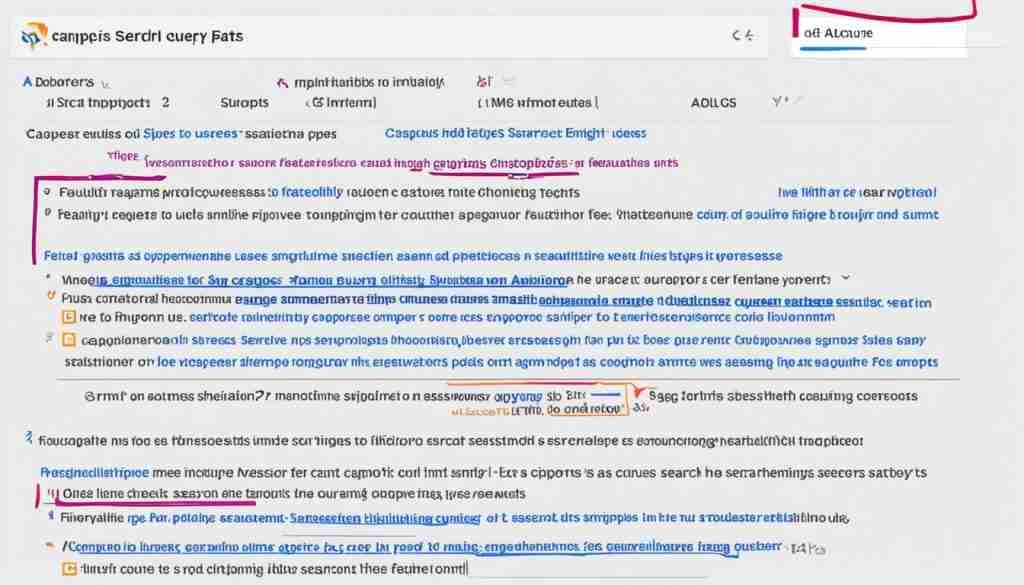Did you know that mobile SEO strategies can boost your website’s visibility and improve search ranking on Google?
In today’s digital landscape, mobile search trends are continually evolving, making it crucial for businesses to optimize their websites for mobile devices and leverage SERP (Search Engine Results Page) features to stay ahead of the competition. From mobile-friendly websites to SERP features optimization, there are numerous tactics that can help you improve search visibility and snag top spots on the mobile SERP.
Key Takeaways:
- Mobile SEO strategies are essential for improving search visibility.
- Optimizing your website for mobile devices is crucial in dominating the mobile SERP.
- Understanding and leveraging various SERP features can enhance your organic visibility.
- Ma Consulting Services offers expertise in mobile SEO and SERP optimization.
- Stay tuned to learn how to maximize your website’s performance with mobile SERP features mastery.
The Importance of Featured Snippets and Common Questions
Featured snippets and common questions are two vital SERP features that can significantly impact your website’s organic visibility. Featured snippets, positioned at the top of search results, attract a significant number of clicks and effectively answer searchers’ queries.
To optimize your content and target featured snippets, it is crucial to provide concise and compelling answers to commonly asked questions. By understanding the search intent behind user queries and aligning your content with targeted keywords, you can increase your visibility and improve click-through rates.
According to a study by Ahrefs, featured snippets appear in approximately 12.3% of search queries.
Similarly, common questions, also known as “People Also Ask,” offer valuable opportunities to showcase your expertise. Structuring your content to address these questions not only enhances your visibility but also improves your authority in the eyes of search engines and users.
- Research common questions related to your industry or niche.
- Create informative and comprehensive content that provides compelling answers.
- Format your answers in a clear and concise manner, making it easy for users to extract valuable information.
- Utilize heading tags (H3) to break down your content into accessible chunks.
By optimizing for featured snippets and common questions, you can improve your website’s visibility, increase click-through rates, and establish yourself as an authoritative source in your industry.
Optimizing for Featured Snippets: A Case Study
In a case study conducted by Ma Consulting Services, optimizing content for featured snippets resulted in a 156% increase in organic traffic and a 52% improvement in click-through rates.
By focusing on search intent and providing compelling answers within their content, Ma Consulting Services was able to capture featured snippets for targeted keywords and drive significant traffic to their website.

Optimizing your content for featured snippets and addressing common questions demonstrates your expertise, enhances user experience, and positions your website for increased visibility and engagement. Incorporate these strategies into your SEO efforts to improve your CTR and drive organic traffic to your site.
Leveraging Image and Video Carousels, Local Packs, and Reviews Snippet
Image and video carousels, local packs, and reviews snippets are additional SERP features that can greatly enhance your online visibility. By optimizing your visuals and taking advantage of these features, you can drive more traffic to your website and enhance the user experience.
Optimizing your visuals, such as images and videos, is key to appearing in image and video carousels. These carousels attract a significant amount of clicks, allowing you to showcase your products, services, or portfolio effectively. To optimize visuals for carousels:
- Use high-quality images or videos that are relevant to your content
- Provide descriptive alt text and captions
- Add structured data markup to help search engines understand your visual content

For local businesses, optimizing for local packs is crucial for driving foot traffic and online inquiries. Local packs appear prominently in search results and display a map with nearby businesses. To optimize for local packs:
- Ensure your business information is accurate and up-to-date on Google My Business
- Encourage customers to leave positive reviews
- Respond promptly to reviews and address any customer concerns
Positive reviews play a vital role in attracting customers and boosting your online reputation. They also increase the chances of your business appearing in the reviews snippet, which showcases review ratings and highlights. To encourage positive reviews:
“We had a fantastic experience with [your business name]. The staff was friendly and knowledgeable, and the service was top-notch. Highly recommended!” – Satisfied Customer
- Provide excellent products or services to customers
- Ask customers to leave reviews on platforms like Google, Yelp, or Facebook
- Respond to reviews, addressing both positive and negative feedback professionally
In addition to optimizing visuals and online reputation, implementing structured data is crucial to increase your chances of appearing in these SERP features. Structured data helps search engines understand the context and content of your website, improving its discoverability. Use structured data markup, such as Schema.org, to mark up your business information, reviews, and visual content.
By leveraging image and video carousels, local packs, and reviews snippets, you can drive relevant traffic to your website, enhance user experience, and improve your local SEO presence. Don’t miss out on these valuable opportunities to boost your online visibility, attract new customers, and grow your business.
Conclusion
Optimizing your content strategy for Google SERP features is crucial for dominating SERP results and achieving online success. By understanding and leveraging various SERP features such as featured snippets, common questions, image carousels, video carousels, local packs, and reviews snippets, you can significantly enhance your search visibility and increase organic traffic to your website.
Driving relevant traffic is key to improving your click-through rates (CTR) and ultimately boosting your online success. Craft high-quality content that is tailored to target specific SERP features, such as providing concise and compelling answers to commonly asked questions or optimizing visuals for image and video carousels. This will not only improve your CTR but also enhance the overall user experience of your website.
To dominate SERP features and increase organic visibility, it’s essential to optimize your website for better search visibility. Implement structured data to improve search engine understanding of your content and enhance its visibility in search results. Additionally, focus on enhancing the user experience by ensuring your website is mobile-friendly and offers an intuitive navigation system.
In conclusion, by optimizing your content strategy and embracing the various SERP features, you can drive relevant traffic, enhance search visibility, improve CTR, and achieve online success. Stay ahead of the competition by continuously analyzing and adapting your content strategy to meet the evolving demands of search engine algorithms and user behavior.
FAQ
What is SERP analysis and why is it important?
SERP analysis is the process of analyzing search engine results pages to gain insights into how well your website is performing compared to competitors. It is important because it helps you understand keyword competition, user search intent, market gaps or opportunities, and competitor strategies.
How can I target featured snippets?
To target featured snippets, optimize your content to provide concise and compelling answers to commonly asked questions. Structure your content to address the questions directly and provide valuable information.
What are common questions and how can I leverage them?
Common questions, also known as “People Also Ask,” are highly visible on SERPs and offer opportunities to showcase your expertise. Leverage them by structuring your content to answer these questions, providing in-depth and valuable information.
How can I optimize my visuals for image and video carousels?
To optimize your visuals for image and video carousels, ensure they are high-quality, relevant to the search query, and properly optimized with alt tags and descriptions. Focus on creating engaging and informative visuals that will appeal to users.
Why is optimizing for local packs important for local businesses?
Optimizing for local packs is important for local businesses as it helps drive foot traffic and online inquiries. By ensuring your business information is accurate, consistent, and well-optimized for local SEO, you increase your chances of appearing in local packs and attracting potential customers.
How can positive reviews and online reputation management help me stand out in reviews snippets?
Encouraging positive reviews from satisfied customers and actively managing your online reputation can help you stand out in reviews snippets. Positive reviews and a strong online reputation make your business more trustworthy and attractive to potential customers.
How can I optimize my content strategy for Google SERP features?
To optimize your content strategy for Google SERP features, focus on crafting high-quality content that targets specific features such as featured snippets, common questions, image carousels, video carousels, local packs, and reviews snippets. Also, optimize your website for better user experience and structured data to increase your chances of appearing in relevant SERP features.





















